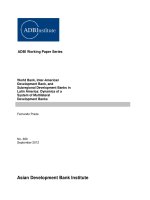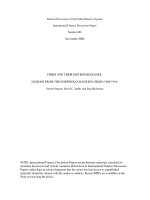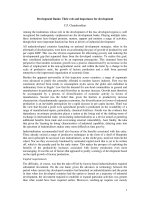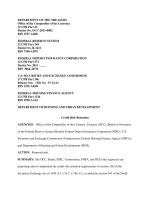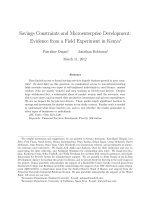bretton woods institutions and multilateral development banks 2018
Bạn đang xem bản rút gọn của tài liệu. Xem và tải ngay bản đầy đủ của tài liệu tại đây (1.9 MB, 22 trang )
Development Finance, MPP, VJU
Prof. Koji Fujimoto
Class 4 Bretton Woods Institutions and Multilateral Development Banks
1. The Birth of the Bretton Woods Institutions (Refer to Reference/Appendix 1)
What did happen in the process of creating the Bretton Woods Institutions vis-àvis the International Trade Organization (ITO) and the United Nations (UN)?
2. Impact of the Bretton Woods Institutions
Have the Bretton Woods Institutions contributed to world economic
stabilization and development?
3. Visions and Realities
How have visions and realities of the Bretton Woods institutions deferred over
time?
(1) The International Monetary Fund (IMF)
(2) The World Bank
(3) The General Agreement on Tariffs and Trade (GATT in place of ITO)
4. Fatal Flaws
Why the Bretton Woods Institutions are not functioning as expected today?
What went wrong with the Bretton Woods Institutions?
5. A Blueprint for Reform
(1) IMF
What kinds of specific reform measures are thinkable?
(2) The World Bank
What kinds of specific reform measures are considered?
(Study Reference 1/Appendix 1 “Chapter 14 of Mahbub ul Haq’s Reflection on
Human Development, 1995.”)
6. Reform Proposals for IMF and Multilateral Development Banks (Appendix 2)
How should IMF and MDBs be reformed? Comment on Appendix 2.
(1) Meltzer Report (2000)
(2) Lawrence Summer’s Proposal (1999)
(Study Reference 2/Appendix 2 “A Comparison of Reform Proposals for the IMF
and Multilateral Development Banks.”)
1
Development Finance, MPP, VJU
Prof. Koji Fujimoto
Bretton Woods Institutions Today
1. International Monetary Fund: IMF
Headquarters: 700 19th Street, N.W., Washington D.C. 20431, U.S.A.
Establishment: Established in December 1945.
Operation started in March 1947.
Purposes (Article I - Purposes):
(i)
To promote international monetary cooperation;
(ii)
To facilitate the expansion and balanced growth of international
trade;
(iii ) To promote exchange stability;
(iv) To assist in the establishment of a multilateral system of payments; and
(v) To make its resources available (under adequate safeguards) to members
experiencing balance of payment difficulties.
Membership: 189 countries (as of 2017). Japan joined IMF in August 1952.
Organization:
(1) Board of Governors
The Board of Governors is the highest decision-making body of the IMF. It consists of
one governor and one alternate governor for each member country. The governor
is appointed by the member country and is usually the minister of finance or the
governor of the central bank. All powers are vested in the Board of Governors.
The Board of Governors may delegate to the Executive Board all except certain
reserved powers. The Board of Governors normally meets once a year at the
IMF-World Bank Annual Meetings.
(2) Executive Board
The Executive Board is composed of 25 Executive Directors and their Alternates
appointed (6) or elected (19) by member countries.
The day-to-day work of the IMF is conducted at its Washington DC headquarters by its
24-member Executive Board; this work is guided by the IMFC and supported by
the IMF’s professional staff. The Managing Director is the Head of IMF staff and
Chairman of the Executive Board.
The Executive Board meets regularly and normally three times a week.
(3) Managing Director
Ms Christine Lagarde from France is the Managing Director. She succeeded Mr.
Dominique Strauss-Kahn from France on July 5, 2011. The term is 5 years.
2
Development Finance, MPP, VJU
Prof. Koji Fujimoto
(4) International Monetary and Financial Committee
The IMFC was established on September 30, 1999, by a resolution of the IMF Board of
Governors, to replace the Interim Committee of the Board of Governors on the
International Monetary System (usually known simply as the Interim Committee),
which had been established in 1974. As the Interim Committee did, the IMFC
usually meets twice a year, in September or October before the IMT-World Bank
Annual Meetings, and in March or April at what are referred to as the Spring
Meetings.
Like the Interim Committee, the IMFC has the responsibility of advising, and reporting
to, the Board of Governors on matters relating to the Board of Governors’
functions supervising the management and adaptation of the international
monetary and financial system, including the operation of the adjustment process,
and in this connection reviewing developments in global liquidity and the transfer
of resources to developing countries; considering proposals by the Executive
Board to amend the articles of Agreement; and dealing with disturbances that
might threaten the system.
The IMFC has 24 members who are Governors of the IMF (generally ministers of
finance or central bank governors). The membership reflects the composition of
the IMF’s Executive Board: each member country that appoints, and each group
of member countries that elects, an Executive Director appoints a member of the
IMFC. A number of international institutions, including the World Bank,
participate as observers in the IMFC’s meeting.
(5) Development Committee
The Joint Ministerial Committee of the Boards of Governors of the Bank and Fund on the
Transfer of Real Resources to Developing Countries, better known as the
Development Committee, was established in October 1974 to advise the Board of
Governors of the IMF and World Bank on critical development issues and on the
financial resources required to promote economic development in developing
countries. Over the years, the Committee has interpreted its mandate to include
trade and global environmental issues in addition to traditional development
matters. The Committee usually meets twice a year, just like the IMFC.
The Development Committee has 24 members (usually ministers of finance or
development) who together represent the full membership of the IMF and World
Bank. Each is appointed for periods of two years by one of the countries or groups
of countries that designates a member to the World Bank’s or the IMF’s Executive
Board. In addition, there is a chairman. Altogether, there are 25 members in the
3
Development Finance, MPP, VJU
Prof. Koji Fujimoto
Committee.
(6) Staff
There are approximately 2,700 employees from 148 countries (as of 2017).
Resources:
(1) Accounts
(i) General Department Accounts (General Resources Account, Special Disbursement
Account and Investment Account)
(ii) SDR Department Account
(iii) Poverty Reduction and Growth Facility and Exogenous Shocks Facility Trust
Account
(iv) PRGF-HIPC Trust and Related Accounts
(v) The Other Administered Accounts
(2) IMF Quotas
Quota subscriptions generate most of the IMF’s financial resources. Each member of
the IMF is assigned a quota, based broadly on its relative size in the world
economy. A member’s quota determines its maximum financial commitment to the
IMF and its voting power, and has a bearing on its access to IMF financing. A
member must pay its subscription in full upon joining the Fund: up to 25% must be
paid in SDRs or widely accepted currencies (such as the U.S. dollar, the euro, the
yen, or the pound sterling), while the rest is paid in the member’s own currency.
Total quotas as of February 2017 were SDR 475.4 billion (about US$668 billion).
Table 1 Quota and Votes of Major Countries as of 2017
4
Development Finance, MPP, VJU
Prof. Koji Fujimoto
(3) IMF Borrowing Arrangements
While quota subscriptions of member countries are its main source of financing, the
IMF can activate supplementary borrowing arrangements if it believes that
resources might fall short of members’ needs. Through the General Arrangements
to Borrow (GAB) and the New Arrangements to Borrow (NAB), a number of
member countries stand ready to lend additional funds to the IMF.
(i) GAB since 1962
GAB enables the IMF to borrow specified amounts of currencies from 11 industrial
countries (or their central banks), under certain circumstances, at market-related
rates of interest. The potential amount of credit available to the IMF under GAB
totals SDR 17 billion (about $25 billion), with an additional SDR 1.5 billion
available under an associated arrangement with Saudi Arabia.
(ii) NAB since 1998
The Mexican financial crisis caused the creation of NAB. NAB is a set of credit
arrangements between the IMF and 26 members and institutions to provide
supplementary resources to the IMF to forestall or cope with an impairment of the
international monetary system or to deal with an exceptional threat to the stability
of that system.
NAB does not replace GAB. However, NAB would typically be the first and
principal resource in the event of a need to provide supplementary resources to
the IMF. The maximum amount or resources available to the IMF under both
borrowing arrangements is SDR 34 billion (about $50 billion).
Lending:
The core responsibility of the IMF is to provide loans to countries experiencing
balance of payment problems. This financial assistance enables countries to rebuild their
international reserves; stabilize their currencies; continue paying for imports; and
restore conditions for strong economic growth. Unlike development banks, the IMF
5
Development Finance, MPP, VJU
Prof. Koji Fujimoto
does not lend for specific projects.
(1) Concessional Facilities for LICs
► Extended Credit Facility (ECF)
ECF was introduced in January 2010 to succeed the Poverty Reduction and Growth
Facility PRGF) as the Fund’s main tool for providing medium-term support to
LICs with protracted balance of payments problems. Financing under the ECF
currently carries a zero interest rate, with a grace period of 5½ years, and a final
maturity of 10 years.
► Standby Credit Facility (SCF)
SCF was introduced in January 2010 to provide financial assistance to LICs with
short-term balance of payments needs. The SCF replaces the High-Access
Component of the Exogenous Shocks Facility (ESF), and can be used in a wide
range of circumstances, including on a precautionary basis. Financing under the
SCF currently carries a zero interest rate, with a grace period of 4 years, and a
final maturity of 8 years.
► Rapid Credit Facility (RCF)
RCF was introduced in January 2010 to provide rapid financial assistance with
limited conditionality to LICs facing an urgent balance of payments need. The
RCF streamlines the Fund’s emergency assistance for LICs, and can be used
flexibly in a wide range of circumstances. Financing under the RFC currently
carries a zero interest rate, has a grace period of 5½ years, and a final maturity of
10 years.
(2) General Facilities
► Stand-By Arrangements (SBA)
The SBA is designed to help countries address short-term balance of payment
problems. The bulk of Fund assistance to middle-income countries is provided
through SBAs. The length of a SBA is typically 12 – 24 months, and repayment
is normally expected within 3¼ – 5 years. SBAs may be provided on a
precautionary basis – where countries choose not to draw upon approved amounts
to retain the option to do so if conditions deteriorate – both within the normal
access limits and in cases of exceptional access. The SBA provides for flexibility
with respect to phasing, with front-loaded access where appropriate.
► Extended Fund Facility (EFF)
The EFF was established in 1974 to help countries address their long-term
balance of payments problems that require fundamental economic reforms.
Arrangements under the EFF are thus longer than SBAs – usually 3 years.
6
Development Finance, MPP, VJU
Prof. Koji Fujimoto
Repayment is normally expected within 4¼ – 10 years.
► Supplemental Reserve Facility (SRF) ⇒ Abolished in March 2009
SRF was introduced in 1997 to meet a need for very short-term financing on a
large scale. The motivation for the SRF was the sudden loss of market confidence
experienced by emerging market economies in the 1990s, which led to massive
outflows of capital and required financing on a much large scale than the IMF had
previously provided. Countries are expected to repay loans within 2 – 2½ years,
but may request an extension of up to an additional six months. All SRF loans
carry a substantial surcharge of 3 – 5% points.
► Compensatory Financing Facility (CFF) ⇒ Abolished in March 2009
CFF was established in 1963 to assist countries experiencing either a sudden
shortfall in export earnings or an increase in the cost of cereal imports, often
caused by fluctuating world commodity prices. Financial terms are similar to
those applying to SBA, except that CFF loans carry no surcharge.
► Emergency Assistance (EA)
EA was established in 1962 to assist countries that have experienced a natural
disaster or are emerging from conflict. Emergency loans are subject to the basic rate
of charge, although interest subsidies are available for some countries, subject to
availability. Loans must be repaid within 3¼ – 5 years.
► Flexible Credit Line (FCL)
FCL was introduced in 2009 to support countries with very strong fundamentals,
policies, and track records of policy implementation and is particularly useful for
crisis prevention purposes. FCL arrangements are approved for countries meeting
pre-set qualification criteria. The length of the FCL is 6 months or 1 year (with a
mid-term review) and the repayment period the same as for the SBA. Access is
determined on a case-by-case basis, is no subject to the normal access limits, and
is available in a single up-front disbursement rather than phased. Disbursements
under the FCL are not conditioned on implementation of specific policy
understandings as is the case under the SBA. There is flexibility to draw o the
credit line at the time it is approved, or it may be treated as precautionary.
Table 2 General Terms of IMF Financial Assistance
7
Development Finance, MPP, VJU
Prof. Koji Fujimoto
2. International Bank for Reconstruction and Development: IBRD (also known as
the World Bank)
Headquarters: 1818 H Street, N.W. Washington D.C. 20433, U.S.A
Establishment: Established in December 1945.
Operations started in June 1946.
Purposes:
(i) To support the long-term human and social development needs that private
creditors do not finance
(ii) Preserve borrowers’ financial strength by providing support in crisis periods,
which is when poor people are most adversely affected;
(iii) To use the leverage of financing to promote key policy and institutional
reforms (such as safety nets or anticorruption reforms);
(iv) To create a favorable investment climate in order to catalyze the provision of
private capital;
(v) To provide financial support (in the form of grants made available from the
IBRD’s net income) in areas that are critical to the well-being of poor
people in all countries.
Membership: 189 member countries (as of 2017). Japan joined in 1952.
Japan borrowed from the IBRD $822.9 million (31 loans between 1953 and
1966).
Organization:
(1) Board of Governors:
Shareholders are represented by the Board of Governors, who are the ultimate policy
8
Development Finance, MPP, VJU
Prof. Koji Fujimoto
makers at the World Bank. Generally, the governors are member countries’
ministers of finance or ministers of development. They meet once a year at the
Annual Meeting of the Board of Governors of the World Bank Group and the
International Monetary Fund.
Because the governors only meet annually, they delegate specific duties to 24 Executive
Directors, who work on-site at the World Bank. The five largest shareholders,
France, Germany, Japan, the United Kingdom and the United States appoint an
executive director, while other member countries are represented by 19 rotated
executive directors.
(2) Board of Executive Directors:
The World Bank Group Board of Executive Directors are responsible for conducting the
day-to-day business of the World Bank. The Boards are composed of 24 Execute
Directors, who are appointed or elected by member countries or by groups of
countries, and the resident, who serves as its Chairman. Regular meetings are
usually held once or twice a week on Tuesdays and Thursdays.
(3) President:
The present President of the World Bank is Mr. Jim Yong Kim, who succeeded Mr.
Robert B. Zoellick in April 2012. The US President nominates the position. The
term can be five years and is renewable.
(4) World Bank Group:
The World Bank Group consists of the International Bank for Reconstruction and
Development (IBRD or World Bank), the International Development Association
(IDA), the International Finance Corporation (IFC), the Multilateral Investment
Guarantee Agency (MIGA) and the International Center for Settlement of
Investment Disputes (ICSID). The first four institutions maintain a Board of
Directors. The Executive Directors serving on these Boards are usually the same.
Under the Articles of IDA and IFC, Executive Directors and Alternate Directors of
the Bank serve ex officio as Executive Directors and Alternates of IDA and IFC, as
long as the country that appoints them, or any one of the countries that have
elected them, is a member of IFC and IDA. Furthermore, it is customary for the
Directors of MIGA to be the same individuals as the Executive Directors of the
World Bank.
(5) Development Committee: (Refer to the IMF)
(6) Staff: Approximately 10,000 (as of 2017).
Table 1 Subscribed Capital, Paid-in Capital and Voting Power of Major Countries
9
Development Finance, MPP, VJU
Prof. Koji Fujimoto
Lending:
(1) Magnitude of Operation
World Bank Commitments and Disbursements
10
Development Finance, MPP, VJU
Prof. Koji Fujimoto
11
Development Finance, MPP, VJU
Prof. Koji Fujimoto
1
12
Development Finance, MPP, VJU
Prof. Koji Fujimoto
(2) Terms and Conditions of IBRD Loans and IDA Credits
Through the IBRD and IDA, two basic type of loans and credits are offered, namely
investment loans and development policy loans. Investment loans are made to
countries for goods, works and services in support of economic and social
development projects in a broad range of economic and social sectors. Development
policy loans (formally known as adjustment loans) provide quick-disbursing
financing to support countries’ policy and institutional reforms.
(i) IBRD Loans
See “IBRD Lending Rates and Loan Charges” of the World Bank Treasury
(ii) IDA Loans
13
Development Finance, MPP, VJU
Prof. Koji Fujimoto
See “IDA Credit Rates and Charges” of the World Bank Treasury.
1. Variable-Spread Loans
2. Fixed Spread Loans
3. “London Interbank Offered Rate”
IBRD Loan Charges
IBRD Loans Whose Invitation to Negotiate Is:
On or After July
31, 1998 and
signed before
Prior to July 31, 1998 May 16, 2007
Front-end Fee
None
1.00% of loan
amount
Contractual
Spread
Loan Charges
14
IBRD loans
signed on or
after May
16, 2007(2)
0.25% of loan
amount
Development Finance, MPP, VJU
Prof. Koji Fujimoto
1.
15
Development Finance, MPP, VJU
Prof. Koji Fujimoto
16
Development Finance, MPP, VJU
Prof. Koji Fujimoto
17
Development Finance, MPP, VJU
Prof. Koji Fujimoto
18
Development Finance, MPP, VJU
Prof. Koji Fujimoto
19
Development Finance, MPP, VJU
Prof. Koji Fujimoto
20
Development Finance, MPP, VJU
Prof. Koji Fujimoto
21
Development Finance, MPP, VJU
Prof. Koji Fujimoto
22



